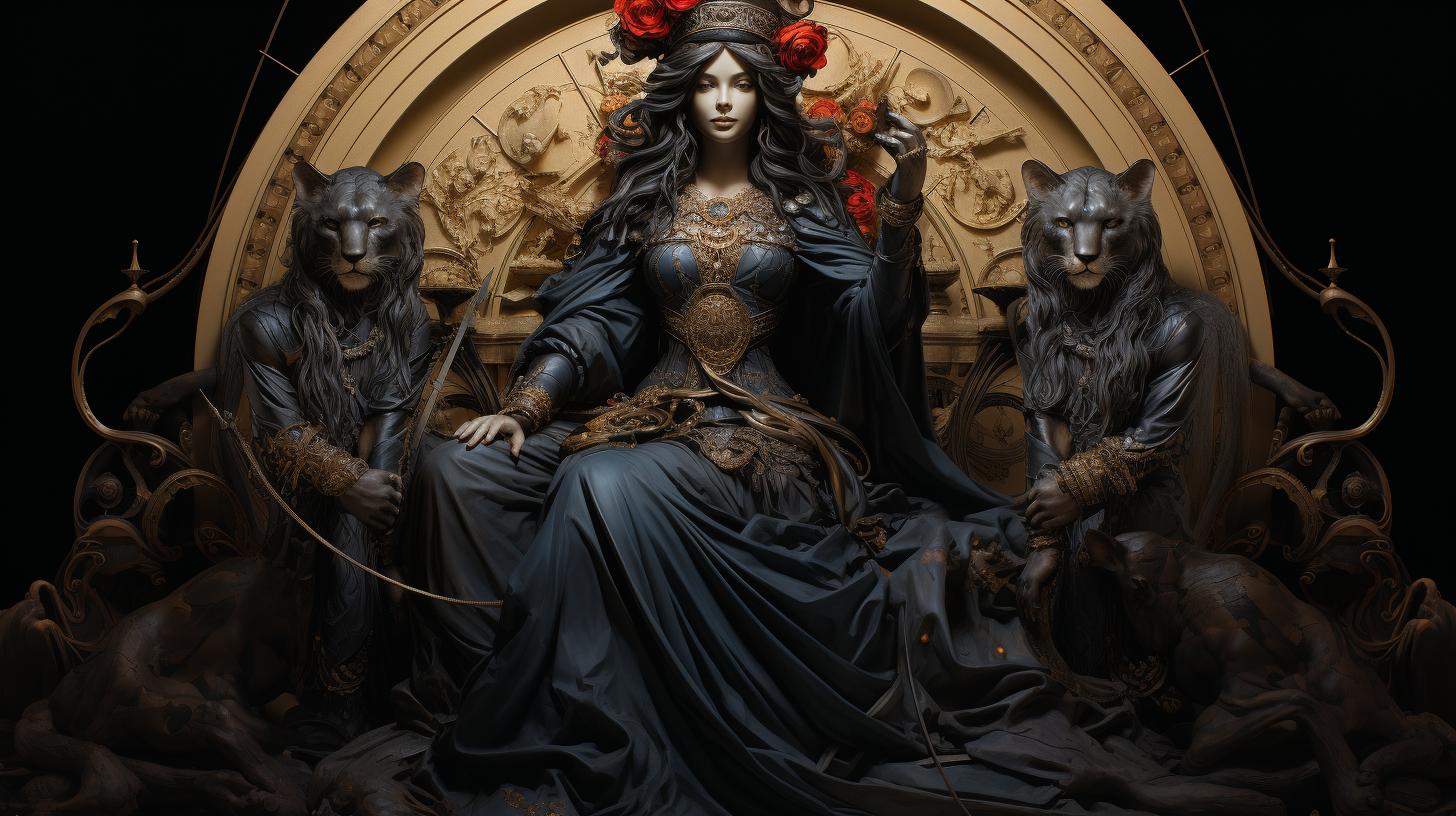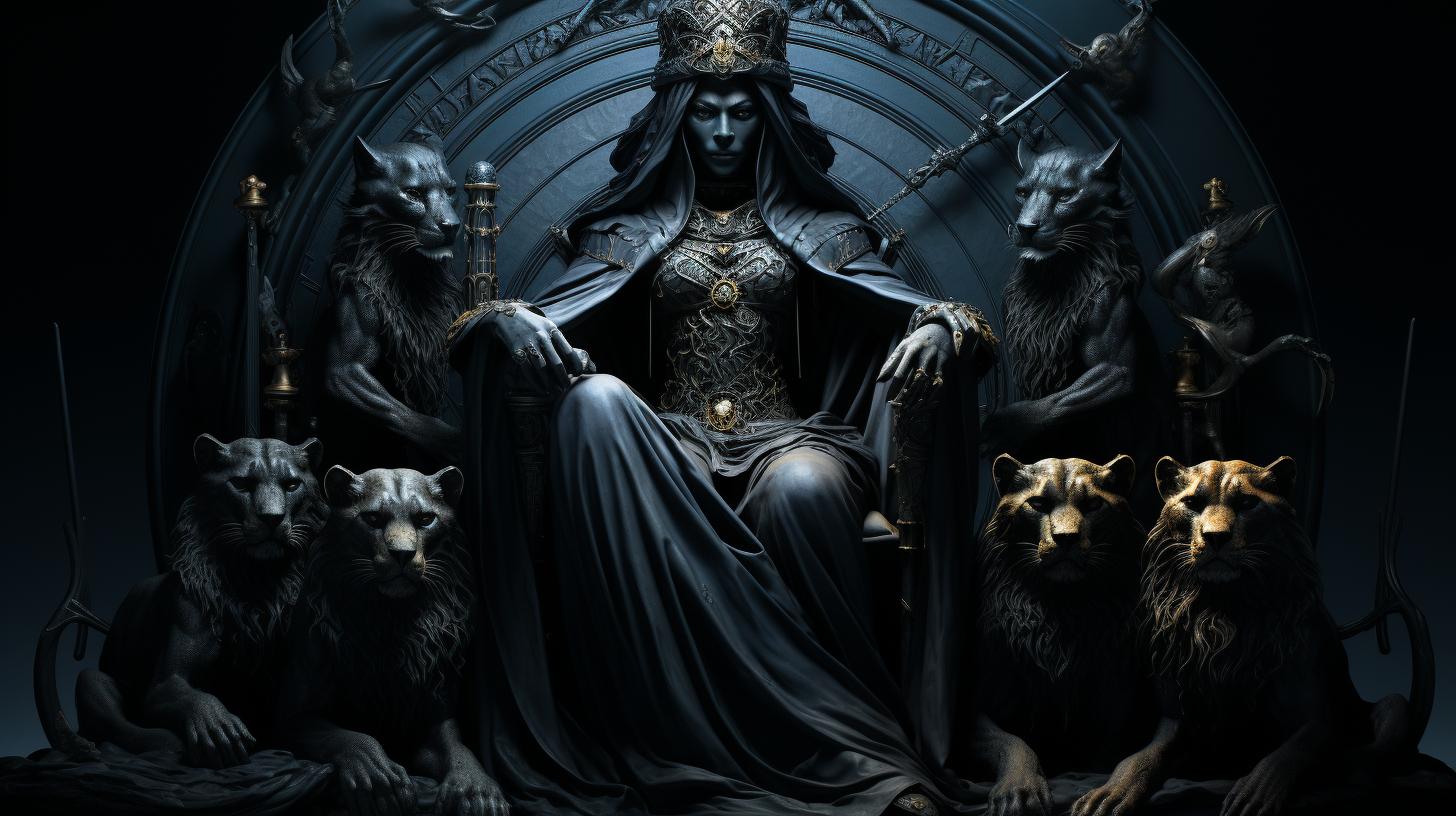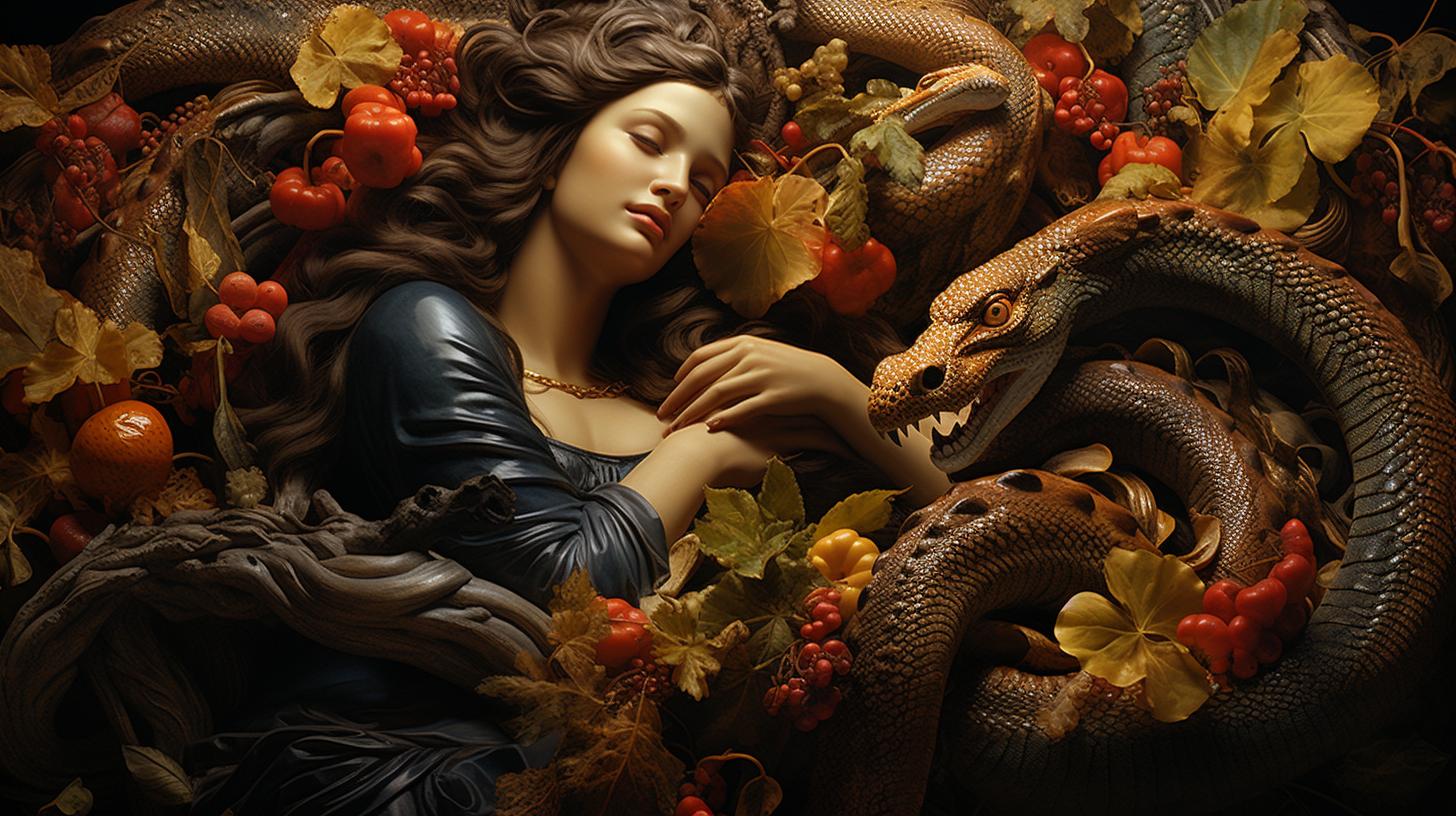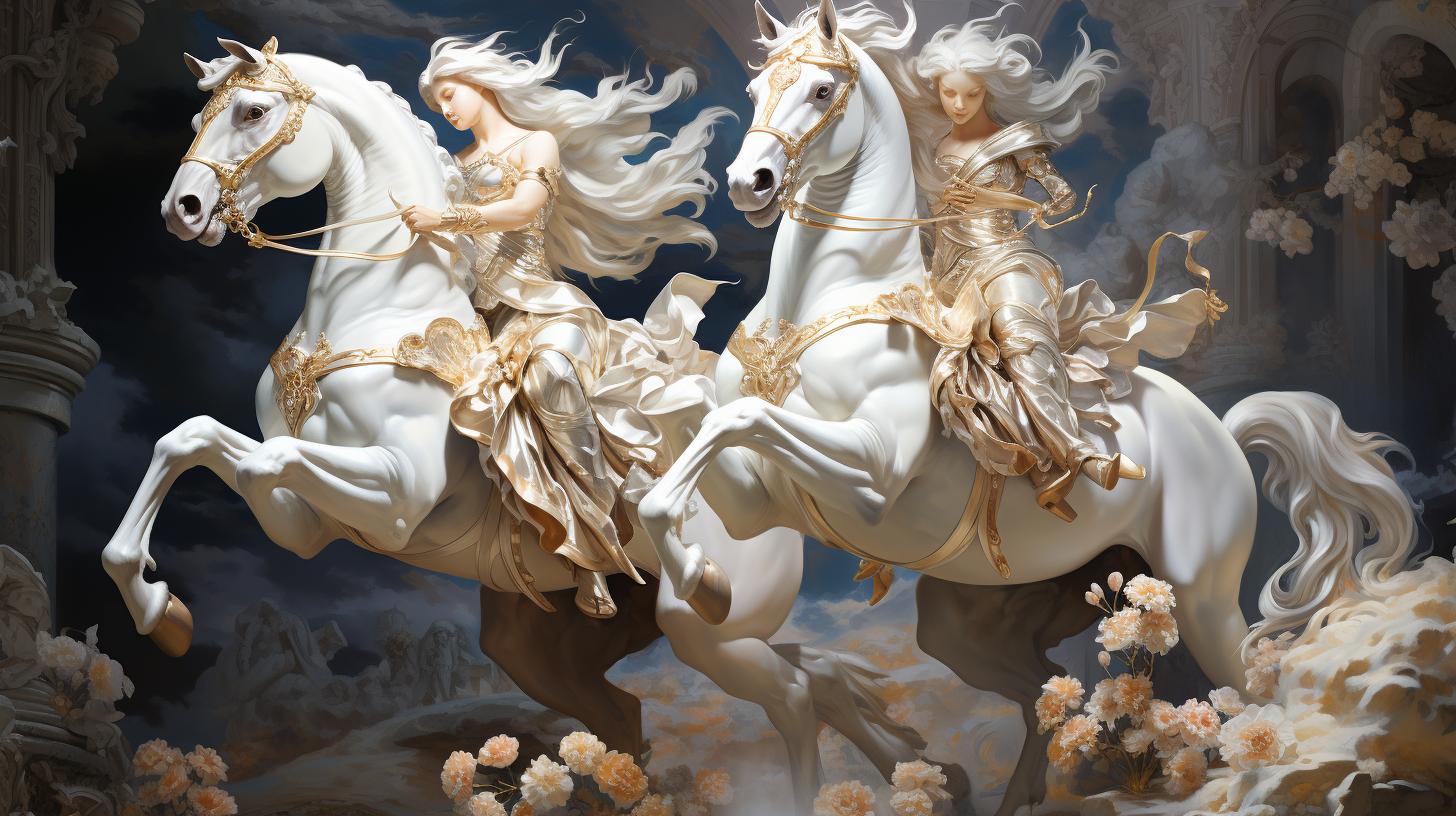What is Cybele the Goddess of in Ancient Phrygian Mythology?

Cybele, the ancient Phrygian goddess, was worshipped with orgiastic rituals and considered the mother of gods. In Greece, she was assimilated with other goddesses and had a mixed reception but was regarded as a protector in Athens.
In Rome, she was known as Magna Mater, and her cult played a significant role as a religious ally. The worship of Cybele included castrated priests called Galli. This article provides an overview of Cybele’s mythology, her cultural impact, associated rituals, and representations in ancient art and architecture, along with her modern reception and legacy.
Overview of Cybele in Ancient Phrygian Mythology
Cybele, the ancient goddess worshipped in Phrygia, holds significant importance in Phrygian culture. She is believed to have originated in this region and played a central role in the religious practices of the Phrygian people.
The worship and rituals surrounding Cybele were elaborate and profound, reflecting the reverence and devotion offered to her by the Phrygians.
The Origins and Significance of Cybele in Phrygian Culture
The exact origins of Cybele in Phrygian culture are shrouded in mystery.
However, she is regarded as a mother goddess, symbolizing fertility, nature, and the cycle of life. Her significance in Phrygian culture was immense, as she represented the foundational aspects of their belief system and played a role in various myths and legends.
The Phrygians considered Cybele as the protector and nurturer of their community and attributed the prosperity of their land to her divine presence.
The Worship and Rituals Surrounding Cybele in Phrygia
The worship of Cybele in Phrygia was characterized by elaborate rituals and ceremonies.
The Phrygians conducted grand processions, featuring elaborate floats and musical performances, to honor and pay homage to the goddess. These rituals involved ecstatic dances, vibrant music, and fervent prayers, creating an atmosphere of spiritual intensity and connection.
Assimilation and Reception of Cybele in Greek Mythology
As Phrygia came into contact with ancient Greece, Cybele’s cult was assimilated and received with mixed reactions. While some Greek communities embraced her as a protective deity, others viewed her with suspicion due to the unfamiliar rituals associated with her worship.
Despite the variations in reception, Cybele’s presence in Greek mythology grew and she became associated with other Greek goddesses.
Cybele’s Role as a Protector in Athens
In Athens, Cybele was revered as a protective goddess.
The Athenians recognized her as a powerful deity who safeguarded the city and its inhabitants. She was seen as a guardian figure, offering divine protection and assistance during times of crisis.
Her presence in Athens contributed to the religious and cultural landscape of the city.
The Roman Cult of Cybele as Magna Mater
When the Roman Empire encountered the cult of Cybele, her worship was not only adopted but also developed into a key religious alliance.
In Rome, she was known as Magna Mater, meaning “Great Mother,” and her cult grew to prominence. The Romans held elaborate festivals and ceremonies in her honor, viewing her as a maternal figure and a symbol of fertility, abundance, and protection.
Cybele’s Connection to Anatolia and Ancient Empires
Cybele, the Phrygian goddess, had a significant influence in Anatolia, particularly among the Phrygians. Her worship was deeply rooted in the region’s culture and played a central role in Phrygian history and empire.
The Influence of Cybele in Anatolia
As one of the most revered deities in Anatolia, Cybele had a profound impact on the religious and spiritual practices of the ancient Anatolian civilizations. Her cult spread throughout the region, encompassing various city-states and communities.
The worship of Cybele brought about cultural exchanges, with Anatolian traditions and beliefs merging with her mythology. It fostered a sense of unity among the people who shared a common devotion to the goddess.
Cybele’s Role in Phrygian History and Empire
The Phrygians, an ancient civilization in Anatolia, held Cybele in high regard and considered her as a symbol of their power and prosperity. She was closely associated with the Phrygian kings, who claimed divine connection and endorsement through her cult.
Cybele’s influence extended beyond religion; she played a significant role in shaping the Phrygian political landscape and influencing their governance. The Phrygian rulers often sought her guidance and blessings, believing that her favor would ensure their success and protection.
Cybele and the Phrygians: Myths and Legends
The mythology surrounding Cybele and the Phrygians was rich and filled with tales of divine encounters, heroic deeds, and legendary figures. These myths served to strengthen the Phrygian identity and their bond with the goddess.
One prevalent legend associated with Cybele is her close association with the mythical figure of Attis. The tale tells of their intertwined fate and serves as a representation of fertility, rebirth, and the cycle of life in Phrygian belief.
Cybele’s Association with King Midas
One of the most famous Phrygian kings associated with Cybele is King Midas. According to ancient accounts, King Midas was a fervent devotee of the goddess. He actively promoted her worship and built grand temples in her honor throughout his kingdom.
Cybele’s association with King Midas further solidified her significance in Phrygian society and showcased her influence over royal figures. It highlighted the importance of the goddess in the political and cultural affairs of the Phrygian empire.
Cybele in the Context of Greek and Roman Mythology
In the world of Greek and Roman mythology, Cybele played a significant role and had various interpretations and connections with other gods and goddesses. Let’s explore the assimilation, adoption, and relationships surrounding Cybele in both mythologies.
Cybele in Greek Mythology: Assimilation and Interpretation
Cybele, originally an ancient Phrygian goddess, was later assimilated into Greek mythology. The Greeks saw her as similar to their own goddesses, such as Rhea and Demeter. She was often depicted as a mother figure and associated with fertility, agriculture, and the Earth.
As Cybele became more integrated into Greek culture, her mythology mingled with existing Greek stories and beliefs. Some interpretations connected her to Zeus as a consort or mother figure to the powerful gods and goddesses of Mount Olympus.
The Roman Cult of Cybele: Adoption and Development
When the Romans encountered the worship of Cybele, they saw similarities between her and their own goddesses. They adopted her cult and developed it further, giving her the title of Magna Mater, meaning Great Mother.
The Romans saw her as a protective and nurturing deity.
The cult of Cybele became an integral part of Roman religious life, with festivals, processions, and rituals dedicated to her. The Romans also incorporated elements from the Phrygian worship of Cybele, including the castrated priests known as Galli, who played a significant role in her rituals.
Cybele’s Relationship with Other Gods and Goddesses
Cybele had intricate relationships with various gods and goddesses in both Greek and Roman mythology. In Greek mythology, she is often connected to Zeus, Hera, and Demeter, among others.
In Roman mythology, Cybele’s influence extended to other deities, such as Jupiter, Juno, and Diana. She was seen as a maternal figure and protector, with her cult often associated with the well-being and safety of the Roman Empire.
Throughout her mythology, Cybele’s relationships with other deities shaped her role and significance, highlighting her connections to fertility, nature, and the divine hierarchy.
Cybele and the Cultural Impact of her Worship
Cybele’s worship had a profound cultural impact on the regions where it spread, particularly in Asia Minor.
Let’s explore the different aspects of her cultural influence.
The Spread of Cybele’s Cult in Asia Minor
The cult of Cybele gained popularity and spread throughout Asia Minor, encompassing various cities and regions. Her influence extended to places such as Phrygia, Lydia, Caria, and beyond. The spread of her cult was facilitated by trade routes, conquests, and cultural exchanges, leading to the assimilation and integration of Cybele’s worship into the fabric of local communities.
Cybele’s Influence on Phrygian Language and Culture
Cybele’s worship had a significant impact on Phrygian language and culture. The myths, rituals, and symbols associated with her cult influenced the Phrygian language, giving rise to new religious terminology. Additionally, her worship shaped Phrygian religious practices, traditions, and social norms, establishing a distinct Phrygian identity rooted in the reverence for Cybele.
Cybele’s Presence in Art and Iconography
The worship of Cybele left a lasting imprint on the art and iconography of the regions where her cult thrived. Depictions of Cybele often portrayed her as a motherly figure adorned with a crown, emphasizing her role as the mother of gods.
Sculptures, reliefs, and mosaics showcased her divine presence, often accompanied by her iconic lions. These artistic representations served to convey the power, fertility, and protection associated with the goddess.
Overall, Cybele’s cultural impact through her worship was extensive, leaving a profound mark on the language, culture, and artistic expressions of the regions where her cult was embraced.
Rituals and Practices Associated with Cybele
The Role of Priests in Cybele’s Worship: The Galli and Castration
In the worship of Cybele, a crucial role was played by the priests known as the Galli. These priests were castrated as part of their dedication to the goddess, and this act served as a form of emulating Cybele’s consort, Attis.
Castration was seen as a sacrifice and a means of attaining spiritual purity. The Galli, being eunuchs, were believed to possess a unique connection to Cybele and acted as her intermediaries in performing sacred rituals and ceremonies.
Orgiastic Rituals and Celebrations in Cybele’s Cult
Cybele’s cult was known for its orgiastic rituals and celebrations. These events were characterized by ecstatic and frenzied behavior, often involving dancing, singing, and drumming. Participants would engage in wild and uninhibited behavior, channeling the primal energy associated with the goddess.
These ceremonies served as a means of connecting with Cybele’s divine presence and invoking her power and blessings. The orgiastic rituals were seen as a way to transcend societal norms and experience a spiritual union with the goddess.
The worship of Cybele and the practices associated with her cult were deeply embedded in the religious and cultural fabric of ancient Phrygia and had a significant impact on the mythology and society of the region.
The role of the Galli priests and their castration, as well as the orgiastic rituals and celebrations, were integral to the expression of devotion and the pursuit of spiritual transcendence in Cybele’s worship.
Cybele’s Symbols and Representations
The symbols and representations associated with Cybele, the ancient Phrygian goddess, played a significant role in depicting her power and influence. Her iconography and attributes showcased her divine nature and the aspects she governed within the ancient pantheon.
Additionally, depictions of Cybele in various forms of ancient art and architecture provided further insights into her significance and worship.
The Cybele Mythology: Her Iconography and Attributes
In the mythology surrounding Cybele, she was often represented with specific iconography and attributes. These symbols served as visual indicators of her divine identity and the realms she presided over. Some of the key symbols associated with Cybele include:
- The lion: The lion symbolized her power, strength, and fierce protective nature.
- The crown: Often depicted with a crown or a mural crown, symbolizing her status as a queen of gods and goddesses.
- The key: The key was a symbol of her ability to unlock the secrets of the earth and grant access to its resources and fertility.
- The drum: The drum represented her association with music, rhythm, and ecstatic rituals.
Depictions of Cybele in Ancient Art and Architecture
Ancient art and architecture showcased various representations of Cybele, providing insights into her worship and cultural significance.
These depictions often portrayed her in a seated or standing position, veiled, and holding a scepter or a tympanum. In sculptures, she was often adorned with intricate and elaborate garments, emphasizing her regal and divine nature.
Ancient temples dedicated to Cybele, known as “Mater Magna” or “Mother of the Gods,” featured architectural elements such as statues and reliefs depicting her and her various attributes. These sacred spaces served as centers of worship and pilgrimage, where devotees could pay homage and seek her blessings.
Artistic representations of Cybele can be found on pottery, mosaics, and frescoes, showcasing her presence in everyday life and rituals. These artworks not only reflected her role as a revered goddess but also offered glimpses into the cultural practices associated with her worship.
In conclusion, Cybele’s symbols and representations, as depicted in ancient art and architecture, provide a visual language that helps us understand her divine nature, powers, and influence. These symbols and depictions serve as a testament to the lasting impact of her worship in ancient Phrygian and subsequent cultures.
Cybele and Historical Events
In addition to being a prominent figure in mythology, Cybele is also associated with various historical events. This section explores two significant events where Cybele played a role – her connection to the Trojan War and her involvement in the Midas Kingdom and Phrygian Wars.
Cybele’s Connection to the Trojan War
Cybele’s connection to the Trojan War stems from her ties to the city of Troy. According to some versions of the myth, Cybele was originally worshipped as an earth goddess in the vicinity of Troy.
She held a unique position due to her association with fertility and nature.
During the Trojan War, the Trojans believed that Cybele’s favor and protection were crucial for their success in battle.
They conducted rituals and offered sacrifices to appease her, seeking her blessings and assistance in defending their city from the Greeks. Cybele’s connection to the Trojan War highlights her significance in the religious and cultural landscape of ancient Troy.
Cybele’s Role in the Midas Kingdom and Phrygian Wars
The Midas Kingdom, ruled by King Midas, was another historical context where Cybele’s influence was prominent. King Midas, known for his infamous golden touch, was closely associated with Cybele and worshipped her as an important deity in his kingdom.
Cybele’s role in the Phrygian Wars also cannot be overlooked. As the Phrygians waged wars against various neighboring groups, Cybele was believed to provide divine guidance and support to her worshippers.
Her presence in these conflicts symbolized her protective and nurturing nature, offering strength and spiritual assistance to the Phrygians.
These historical events demonstrate how Cybele’s cult and worship were deeply intertwined with the political and military dynamics of ancient Anatolia, leaving a lasting impact on the region’s history.
Cybele’s Modern Reception and Legacy
Cybele, the ancient Phrygian goddess, continues to have a significant impact on later mythological figures and contemporary culture and art. Her powerful symbolism and enduring legacy have found resonance in various aspects of modern society.
Cybele’s Influence on later Mythological Figures
The mythological figure of Cybele has influenced and inspired various other goddesses and female deities in different mythological traditions. Her association with motherhood, fertility, and divine power has contributed to the development of similar characters in later mythologies.
- Demeter: In Greek mythology, Cybele’s attributes are often associated with the goddess Demeter. Both goddesses share similar roles as protectors of agriculture and fertility, and their stories exhibit parallels in terms of their maternal nature and interactions with other mythological figures.
- Isis: In Egyptian mythology, the goddess Isis bears resemblances to Cybele.Like Cybele, Isis is a mother goddess associated with fertility, creation, and the nourishment of all living beings. She is also believed to have the power to resurrect the dead, similar to Cybele’s association with rebirth and renewal.
- Magna Mater: Cybele’s Roman persona as Magna Mater greatly influenced later Roman goddesses associated with motherhood and fertility.Her cult practices and rituals, as well as her iconography, had a lasting impact on the worship of goddesses such as Ceres and Juno in the Roman pantheon.
Cybele’s Impact on Contemporary Culture and Art
Cybele’s rich mythology and symbolism continue to inspire artists, writers, and creators in various forms of contemporary culture and art.
Her powerful presence and themes associated with nature, fertility, and divine femininity resonate with modern audiences.
- Literature and Poetry: Cybele’s stories and symbolism have been explored by numerous writers and poets throughout history.From ancient poets like Ovid to modern authors like Margaret Atwood, her character and themes have served as a source of inspiration for exploring the complexities of womanhood, power, and divine connection.
- Visual Arts: Cybele’s representations in ancient art and architecture, with her iconic lion-drawn chariot and majestic presence, have served as inspiration for contemporary artists.Her imagery is often depicted in sculptures, paintings, and other visual mediums, capturing her commanding presence and symbolic significance.
- Feminist Movement: Cybele’s role as a powerful, independent goddess has resonated with feminist movements across time.Her mythology and symbolism have been celebrated as a representation of female strength, reclaiming narratives of female divinity and empowerment.
- New Age Spirituality: Cybele’s association with nature, fertility, and the divine feminine has found resonance in various New Age and spiritual practices.Her worship and rituals have been adapted and incorporated into contemporary spiritual practices focused on earth-based spirituality and goddess worship.
Cybele’s modern reception and legacy continue to evolve and inspire, showcasing the enduring power and significance of this ancient goddess in shaping cultural and artistic landscapes.




















